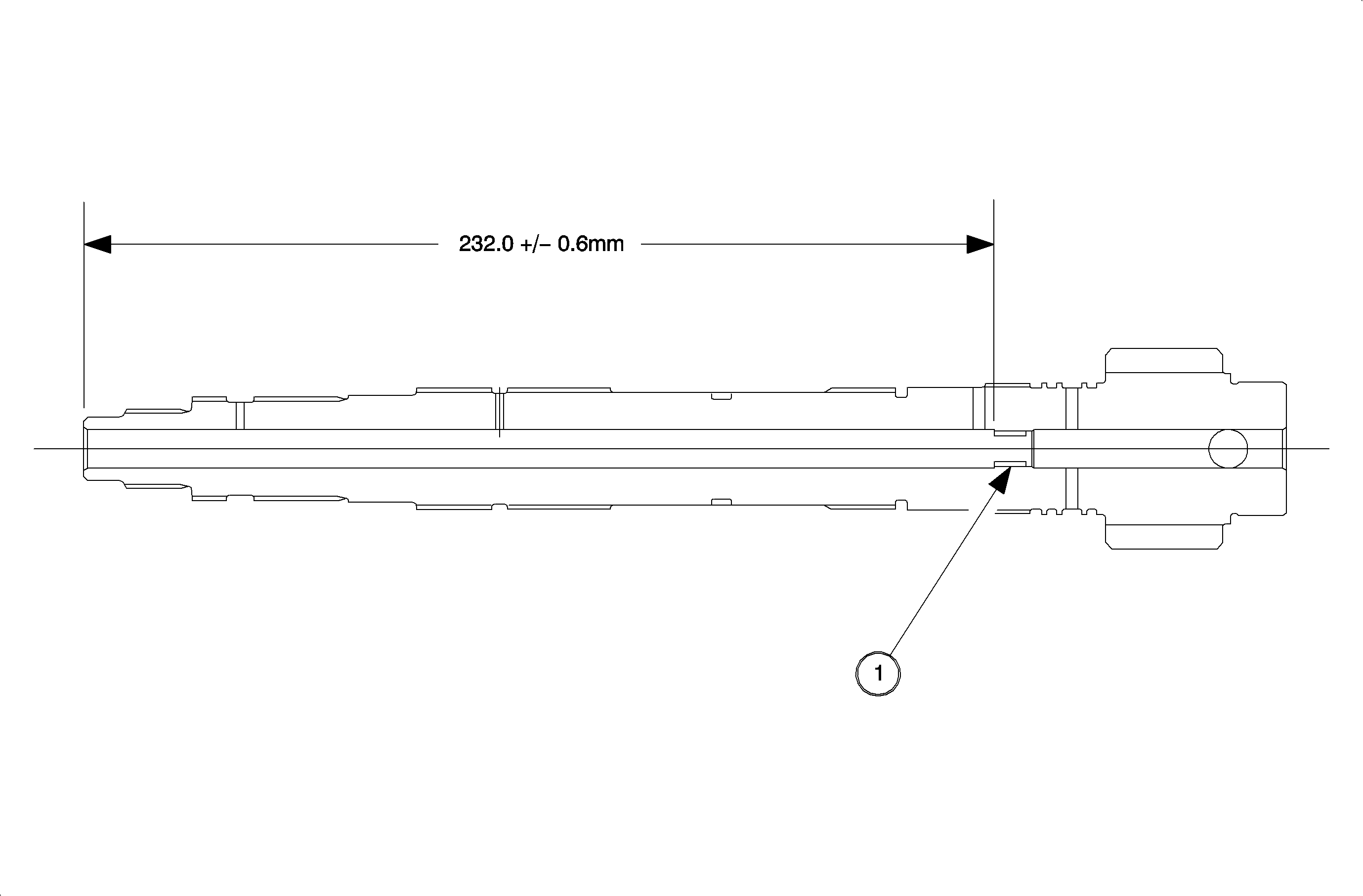Pressure Ports - Transaxle Case
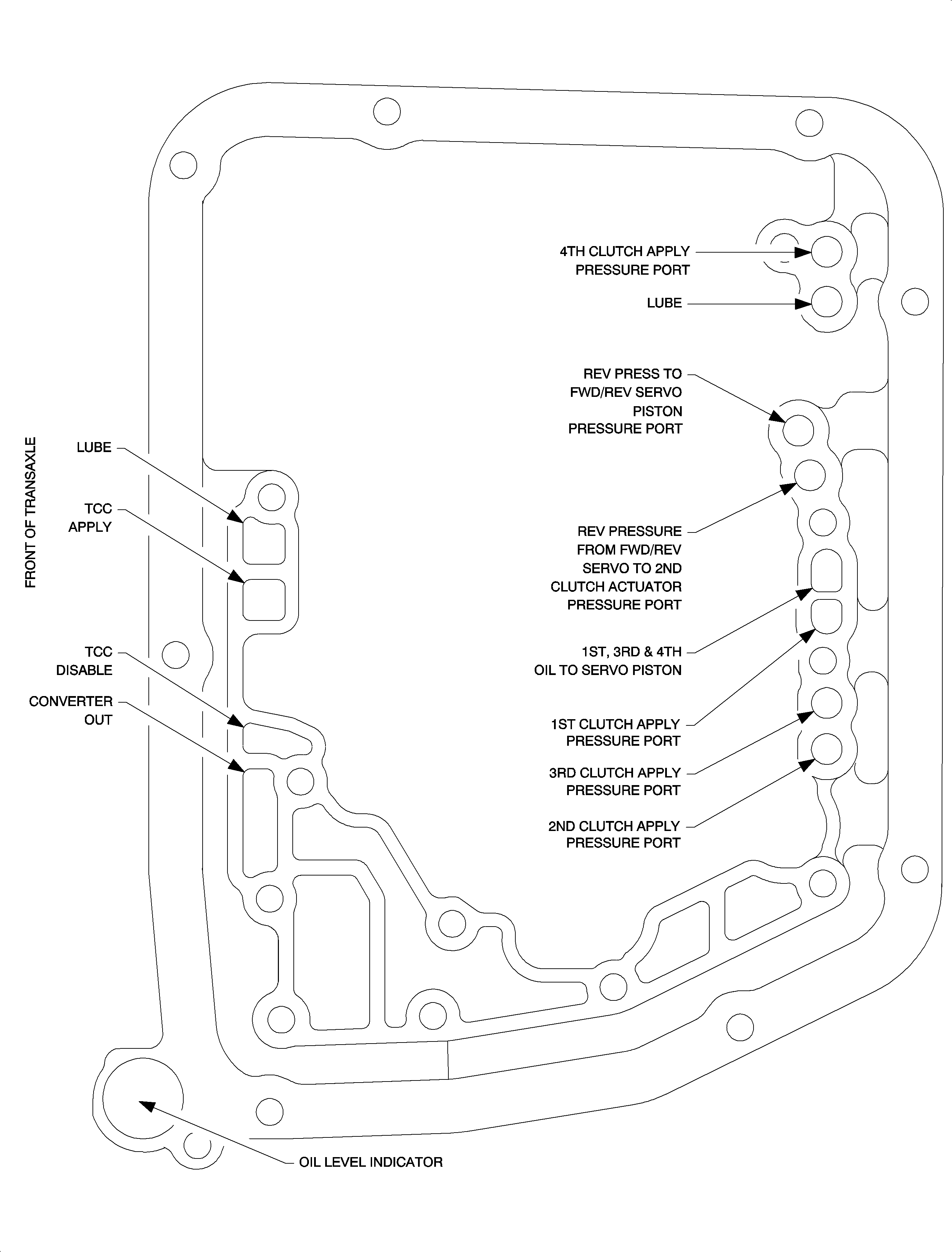
To air check a clutch, apply compressed air to the corresponding pressure port
with a rubber nozzle air gun.
WHEN CHECKING:
| APPLY PRESSURE TO:
|
1st Clutch
| 1st Clutch Apply Pressure Port
|
2nd Clutch
| 2nd Clutch Apply Pressure Port
|
3rd Clutch
| 3rd Clutch Apply Pressure Port
|
4th Clutch
| 4th Clutch Apply Pressure Port
|
Forward/Reverse
Servo Piston
|
- Plug off rev pressure from fwd/rev servo to 2nd clutch solenoid pressure
port.
- Place rag over 1st, 3rd and 4th oil to servo piston to avoid spray.
- Apply air pressure to the rev pressure to fwd/rev servo piston pressure
port.
|
Automatic Transaxle Air Checking Procedure
Caution: Protect yourself by wearing safety glasses, earplugs, a respirator, gloves,
and safety shoes while performing work on the vehicle.
Before you begin:
| • | Regulate the shop air between 80-100 psi. Pressure less than
80 psi or higher than 100 psi may lead to a misdiagnosis. |
| • | Inspect rubber-tipped nozzle to verify that it is in good condition. |
Clutch Air Check Procedure
- Remove the valve body. Refer to
Control Valve Body Assembly Removal
.
- Place rubber-tipped nozzle in proper apply port pressing firmly to create
a good seal between nozzle and apply port.
- Apply air to hydraulic circuit and watch for clutch to move quickly.
Important: A small amount of air bubbles coming from the lube holes of the clutch housing
that is being air checked is normal.
- After clutch has been applied, hold air nozzle tightly against port, forming
a seal, and release trigger on air nozzle. While air nozzle is still held tightly
against port, clutch should hold pressure for approximately one to two seconds before
slowly releasing.
Important: If no air leak at clutch can be found, leak is most likely not a cut/torn clutch
piston, but is more likely one of the other potential causes listed in the section
for the appropriate clutch in question.
- Listen and look for leaks.
1st Clutch Hydraulic Circuit Air Check
To air check 1st clutch hydraulic circuit, apply air to the 1st clutch apply
pressure port. For proper location, refer to "Pressure Ports-Transaxle Case" in this
service manual. Because first clutch is hidden by the transaxle end cover, the clutch
plates cannot be watched for proper apply. When applying first clutch, watch for the
input shaft to move slightly, indicating the clutch has applied or listen for a quick
"clunk" sound to verify that the clutch has applied. If there is any question whether
first clutch is applying, bench test the clutch using an air check fixture, tool P/N
SA9147T.
Notice: A large leak in 1st gear circuit can cause a loss of other forward gears.
A large leak in 1st gear circuit can cause a loss of other forward gears.
| • | Damaged 1st clutch piston (1) . |
| • | Worn or damaged input shaft hub seal ring(s) (2) . |
| • | Damaged servo piston cover O-ring (3) . |
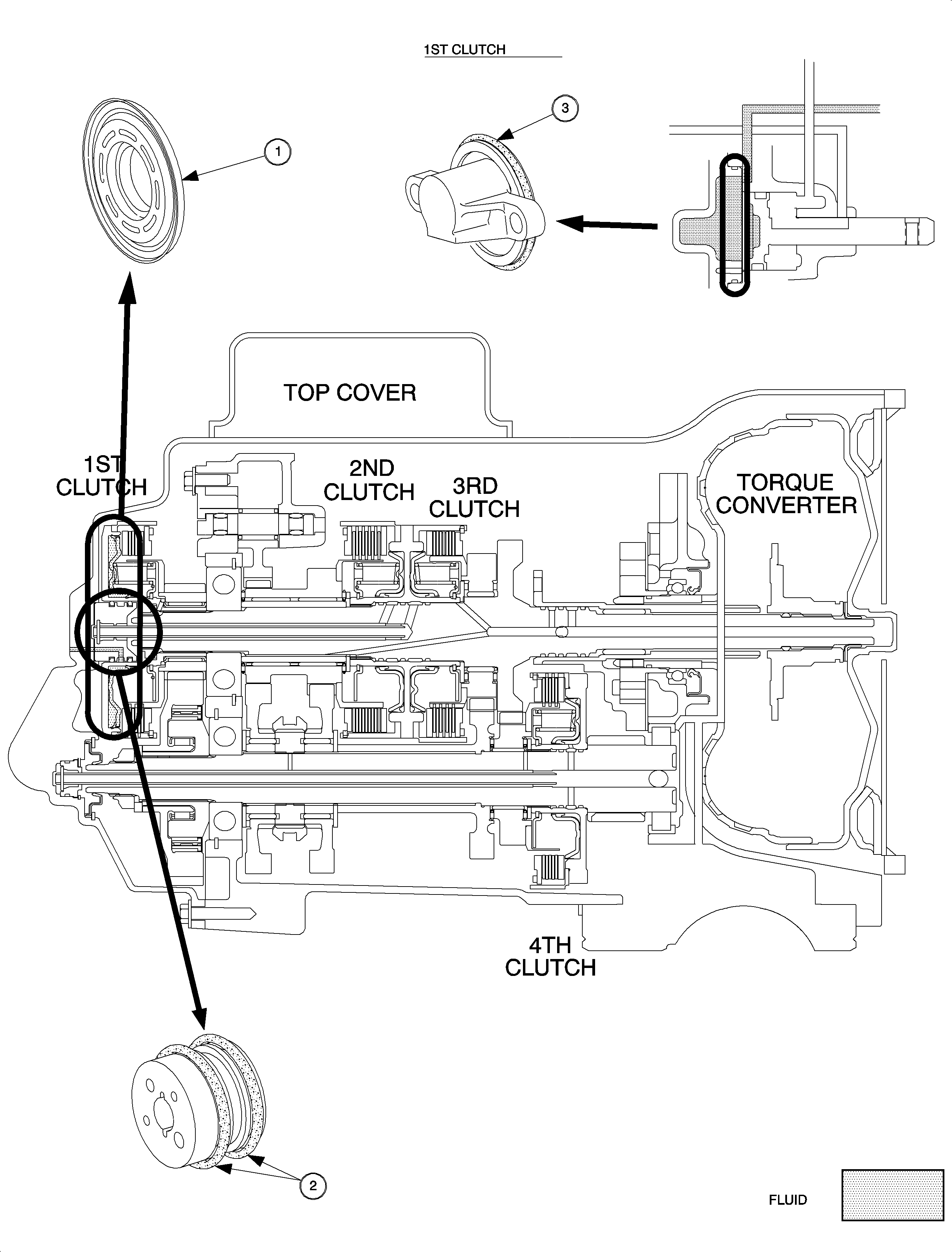
2nd/Rev Clutch Hydraulic Circuit Air Check
To air check 2nd clutch hydraulic circuit, apply air to the 2nd clutch apply
pressure port. For proper location, refer to "Pressure Ports-Transaxle Case" in this
service manual. When applying air to 2nd clutch, a small amount of cross leakage between
2nd and 3rd clutch is normal. This is due to a small amount of normal leakage around
the input shaft feed tube bushing which is located between the 2nd and 3rd clutch.
If 2nd clutch does not apply properly when performing the air check, possible
sources of leakage include:
| • | Damaged 2nd clutch piston (1) . |
| • | Worn or damaged input shaft hub seal ring(s) (2) . |
| | Important: If air/bubbles are observed coming from the lube port when the 2nd clutch apply
pressure port is pressurized, this may be an indication that the input shaft nut is
loose or not properly seated.
|
| • | Input shaft nut not torqued properly/not fully seated (3) . |
| | Important: To verify that the bushing is at the correct depth, refer to the procedure titled
"Misplaced or Loose Input Shaft Inner Tube Bushing Check" procedure in this service
manual.
|
| • | Delivery tube bushing in input shaft mislocated or loose (4) . |
| • | Damaged clutch housing to input shaft O-ring under 2nd clutch (5) . |
| • | Damaged clutch housing to input shaft O-ring seal between 2nd and 3rd
clutches (6) . |
| • | Input shaft inner tube retaining pin out of position/missing (7) . |
| • | Damaged input shaft inner tube O-ring seal (8). |
| • | Damaged/missing delivery tube sleeve (9). |
If the complaint is for reverse, inspect the forward/reverse servo piston following
the procedures below in addition to the 2nd rev clutch hydraulic circuit procedures.
- Plug off the reverse pressure from the forward/reverse servo to 2nd clutch
apply port.
- Place a rag over 1st, 3rd and 4th oil-to-servo piston port to avoid spray.
Caution: As pressure is applied to the reverse pressure to forward/reverse servo piston
pressure port, air pressure will cause a spray-back of oil out of the 1st, 3rd and
4th oil-to-servo piston port. In the event of hot transaxle oil, this could result
in personal injury.
- Apply pressure to the reverse pressure to forward/reverse servo
piston pressure port.
When following the above procedures, the forward/reverse servo piston should
move, pulling the fork toward the reverse driven gear. If the forward/reverse servo
piston does not apply properly, inspect for:
| • | Damaged forward/reverse servo piston cover O-ring (10). |
| • | Damaged forward/reverse servo piston seal (11). |
Important: For detailed information on delay/harsh engagement into reverse, refer to the
"Delay/Harsh Engagement Into Reverse Diagnostic Chart" in this service manual.
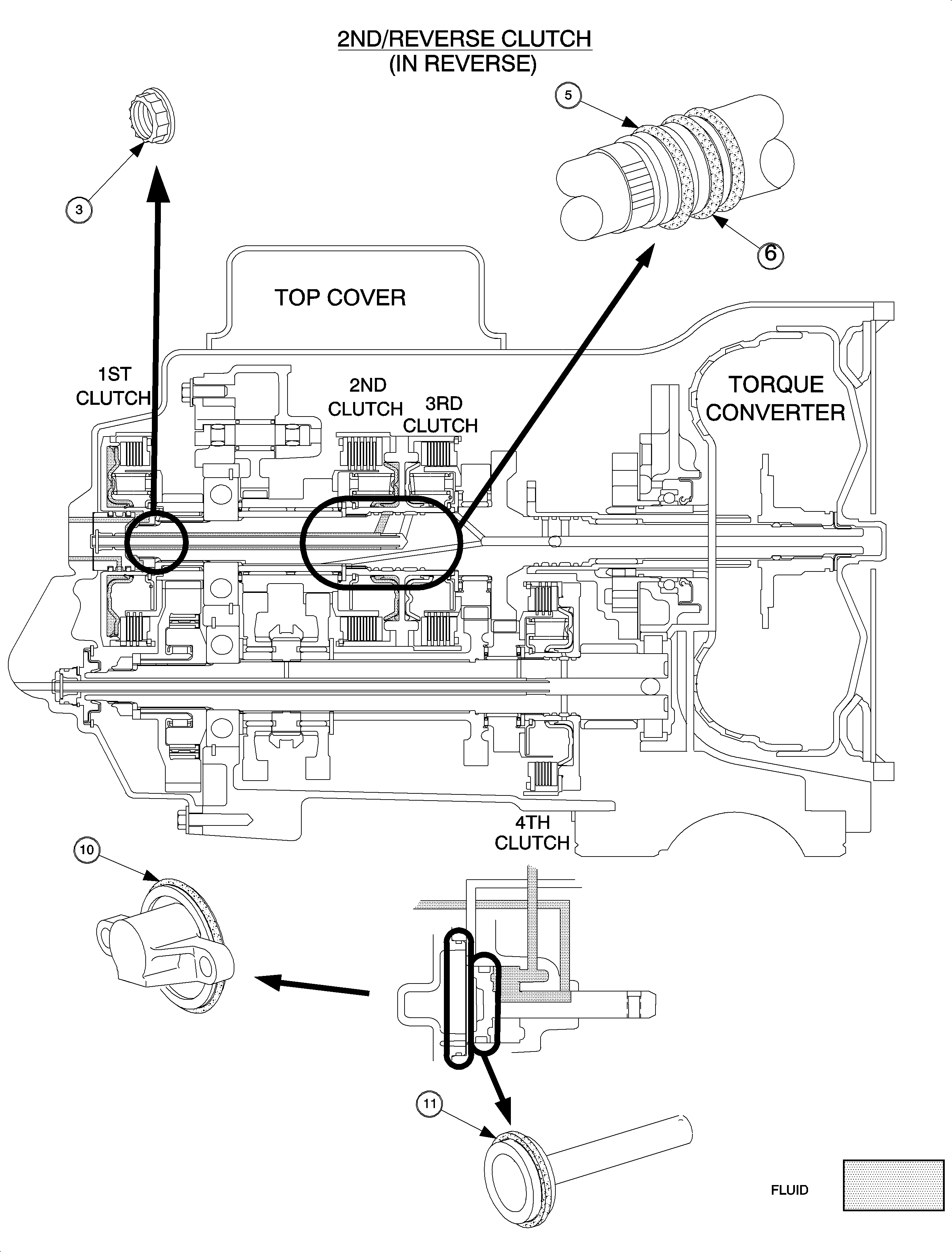
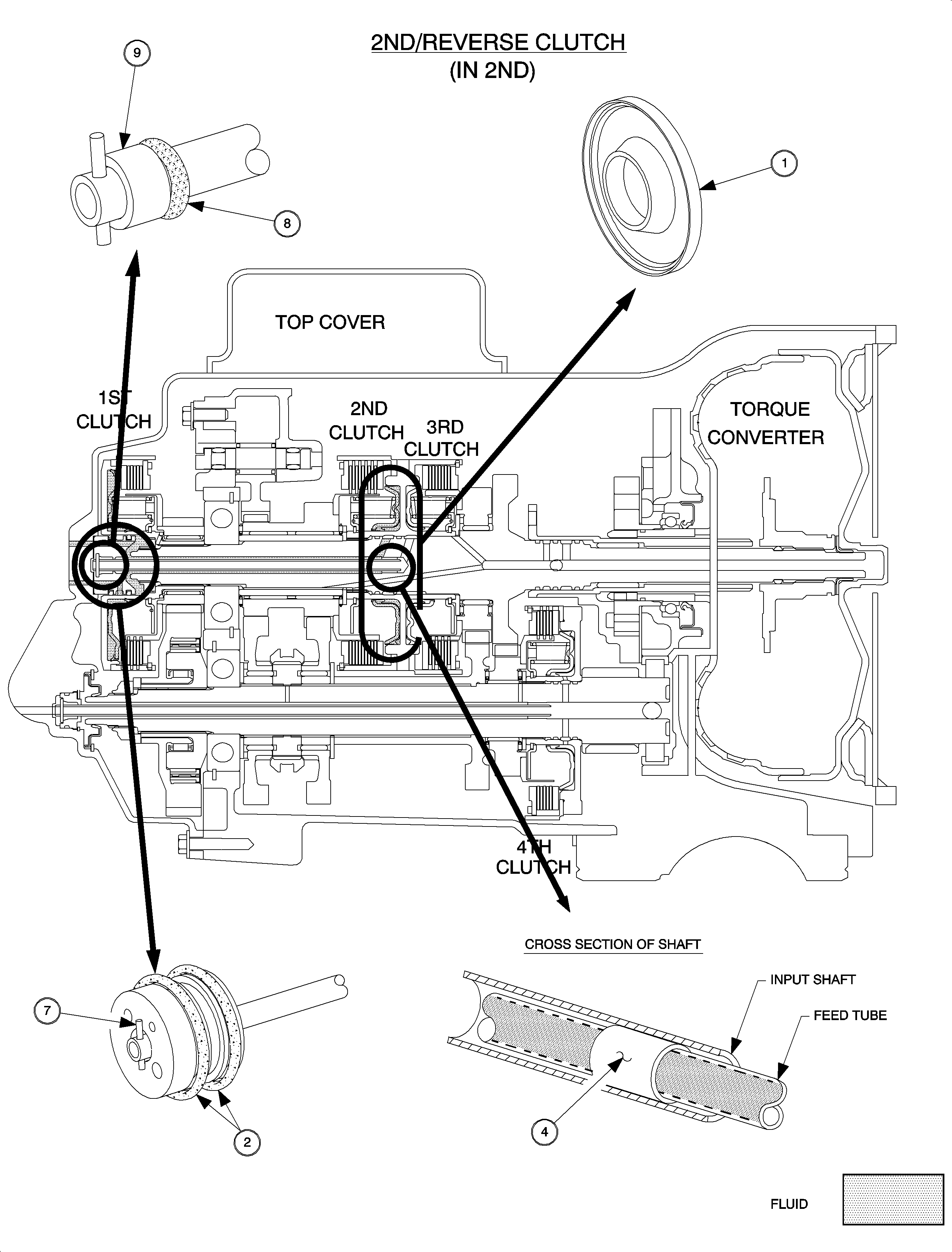
3rd Clutch Hydraulic Circuit Air Check
To air check 3rd clutch hydraulic circuit, apply air to the 3rd clutch apply
pressure port. (For proper location, refer to "Pressure Ports-Transaxle Case" in this
service manual.) When applying air to 3rd clutch, a small amount of cross leakage
between 3rd and 2nd clutch is normal. Second clutch should not immediately apply when
applying air to the 3rd clutch apply port, while blocking the 2nd clutch apply port.
However, it is normal for 2nd clutch to apply within 2-3 seconds after applying air
to the 3rd clutch apply port when the 2nd clutch apply port is blocked. This is due
to a small amount of normal leakage around the input shaft O-ring seal between the
2nd and 3rd clutch.
If 3rd clutch does not apply properly when performing the air check, possible
sources of leakage include:
| • | Damaged 3rd clutch piston (1) . |
| | Important: To verify that the bushing is at the correct depth refer to the procedure titled
"Misplaced or Loose Input Shaft Inner Tube Bushing Check" procedure.
|
| • | Damaged clutch housing-to-input shaft O-ring seal under 3rd clutch (4) . |
| • | Damaged clutch housing-to-input shaft O-ring seal between 3rd and 2nd
clutches (5) . |
| • | Damaged input shaft inner tube O-ring seal (6) . |
| • | Damaged/missing delivery tube sleeve (7) . |
| • | Input shaft inner tube retaining pin out of position (8). |
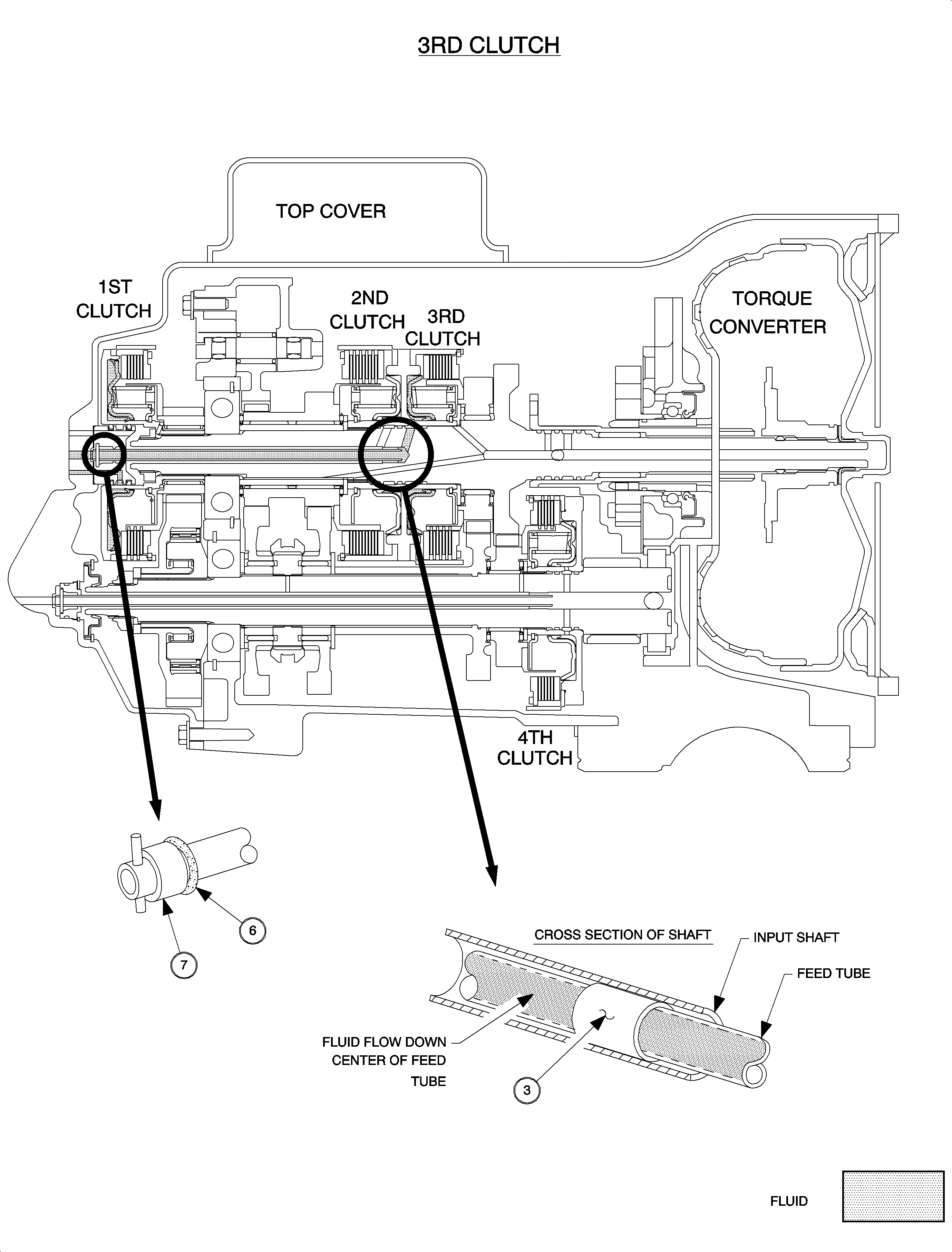

4th Clutch Hydraulic Circuit
To air check 4th clutch hydraulic circuit, apply air to the 4th clutch apply
pressure port. For proper location, refer to "Pressure Ports-Transaxle Case" in this
service manual.
If 4th clutch does not apply properly when performing the air check, possible
sources of leakage include:
| • | Damaged 4th clutch piston seal (1) . |
| • | Damaged/missing delivery tube sleeve (2) . |
| • | Damaged clutch housing-to-output shaft O-ring seal under 4th clutch (3)
. |
| • | Delivery tube bushing in output shaft mislocated or loose (4) . |
| • | Output shaft tube retaining pin out-of-position (5) . |
| • | Damaged output shaft hub O-ring seals (6) . |
| • | Damaged output shaft tube seal ring (7) . |
| • | Output shaft check ball missing (9). |
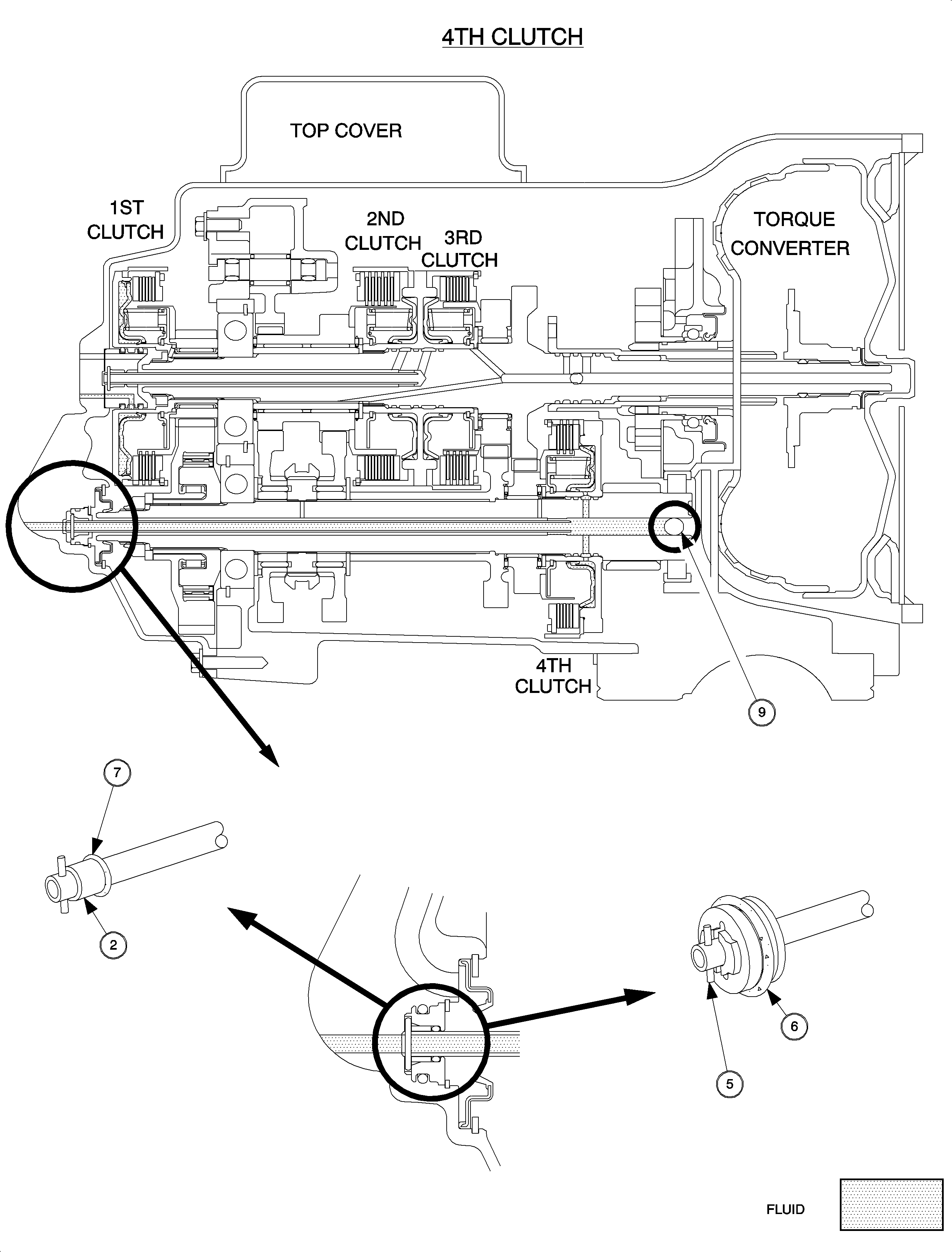
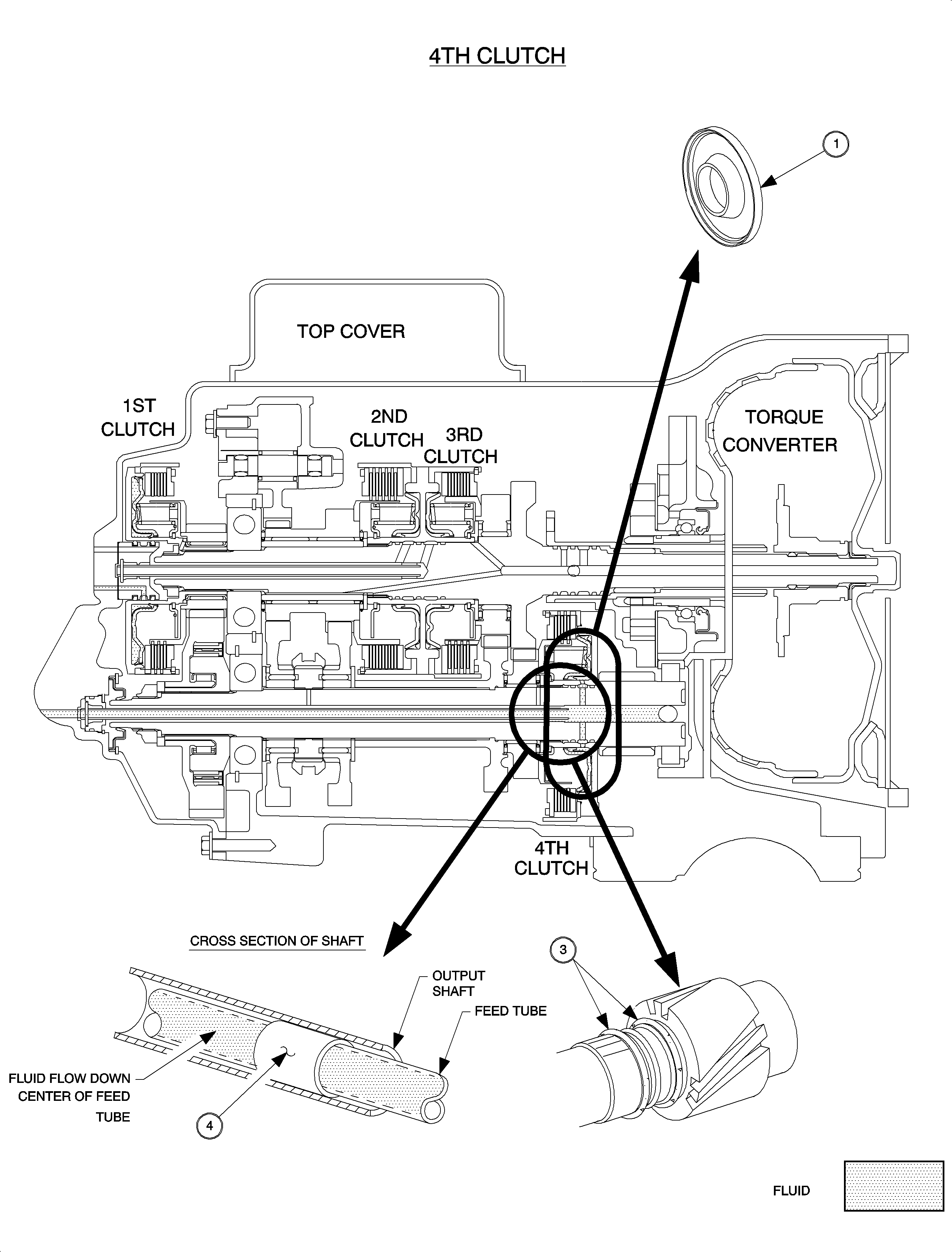
TCC Hydraulic Circuit
The TCC circuit cannot be checked reliably using air with the exception of checking
for a missing input shaft check ball (3) or checking for a leaking Teflon™ seal
that separates lube from TCC disable (4).
Important: When applying air to the lube pressure port, a small amount of leakage will
normally be observed coming from TCC disable and/or converter out. If a gross leak
is observed, inspect for a missing input shaft check ball (3) or leaking Teflon™
seal that separates lube from TCC disable (4).
To check for a missing input shaft check ball (3) or a leaking Teflon™
seal that separates lube from TCC disable (4), regulate air pressure to 25 psi. Apply
air to the lube pressure port (next to TCC apply) and look for a significant amount
of air coming from TCC disable or converter out ports.
Other sources of leaking in the TCC circuit, which cannot be detected with an
air check include:
| • | Damaged input shaft seal ring(s) between TCC disable and lube or converter
out (1), (4). |
| • | Damaged input shaft to converter O-ring (2). |
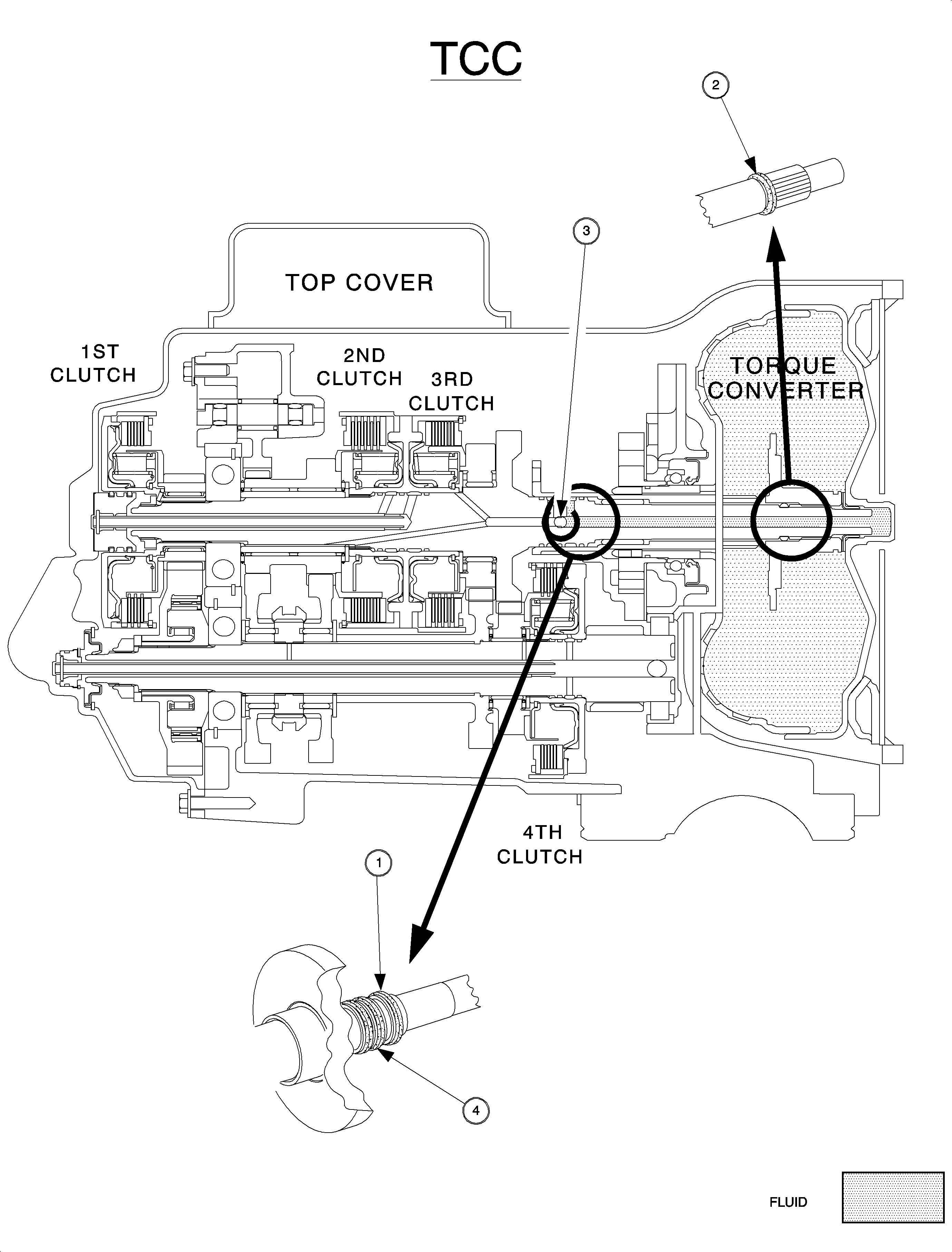
Misplaced Or Loose Input Shaft Inner Tube Bushing Check Procedure
- Remove end cover and 1st driven gear. Refer to
End Cover Replacement
and
1st Clutch, 1st Drive Gear and 1st Driven Gear Replacement - On Vehicle
.
- Obtain a piece of welding rod or straightened coat hanger and insert into
input shaft until the bushing (1) is reached.
- Measure depth of bushing using welding rod or straightened coat hanger
and a ruler. The bushing should be 130.18 ± 3.18 mm (5 1/8 ±
1/8 in) from the 1st clutch end of the input shaft. If the bushing is more
than 133.35 mm (5 1/4 in) or less than 127.0 mm (5.0 in)
deep, the input shaft must be replaced.

Misplaced Or Loose Output Shaft Inner Tube Bushing Check Procedure
- Remove end cover and 1st driven gear. Refer to
End Cover Replacement
and
1st Clutch, 1st Drive Gear and 1st Driven Gear Replacement - On Vehicle
.
- Obtain a piece of welding rod or straightened coat hanger and insert into
output shaft until the bushing (1) is reached.
- Measure depth of bushing using welding rod or straightened coat hanger
and a ruler. The bushing should be 232.0 ± 0.6 mm (9.16 ± 0.02 in)
from the 1st clutch end of the output shaft. If the bushing is more than 232.6 mm
(9.18 in) or less than 231.4 mm (9.14 in) deep, the output shaft
must be replaced.
